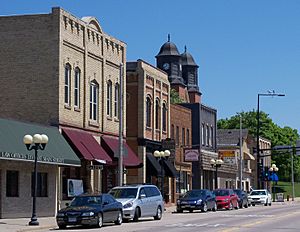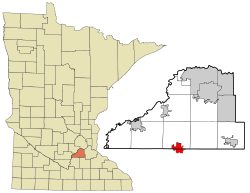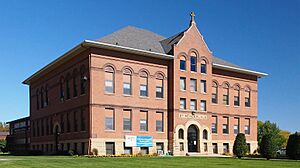New Prague, Minnesota facts for kids
Quick facts for kids
New Prague, Minnesota
|
|
|---|---|

Buildings in downtown New Prague
|
|
| Motto(s):
"A Tradition Of Progress"
|
|

|
|
| Country | United States |
| State | Minnesota |
| Counties | Scott, Le Sueur |
| Area | |
| • Total | 3.87 sq mi (10.02 km2) |
| • Land | 3.87 sq mi (10.02 km2) |
| • Water | 0.00 sq mi (0.00 km2) |
| Elevation | 1,001 ft (305 m) |
| Population
(2020)
|
|
| • Total | 8,162 |
| • Density | 2,109.04/sq mi (814.24/km2) |
| Time zone | UTC-6 (Central (CST)) |
| • Summer (DST) | UTC-5 (CDT) |
| ZIP code |
56071
|
| Area code(s) | 952 |
| FIPS code | 27-45808 |
| GNIS feature ID | 2395211 |
New Prague (pronounced PRAYG) is a city in the state of Minnesota, USA. It is located in two different counties: Scott and Le Sueur. In 2020, about 8,162 people lived there. Even though part of New Prague is in a larger metropolitan area, it has special rules that keep it separate from some regional planning.
Contents
History of New Prague
How New Prague Started
New Prague was founded in 1856. It was named after Prague, which is the capital city of Bohemia (now known as the Czech Republic). Many of the first people who settled here came from Bohemia and identified as Czechs.
A man named Anton Philipp, who was German, was the first to settle in the area. He bought a large piece of land in 1856. He started selling smaller parts of his land, and that's how New Prague began. Soon after, several families from Bohemia moved to the area.
New Prague in the Late 1800s
New Prague grew slowly at first. This was partly because of the American Civil War (1861–1865). During the war, fewer people from Europe came to the United States. Also, the area was covered in thick forests called the "Big Woods," so clearing land for farms was a lot of hard work.
The town was first called Praha from 1872 to 1879. In 1877, the state of Minnesota officially recognized Praha as a village. Then, in 1879, its name was changed to Prague.
A very important event happened in 1877: the Minneapolis and St. Louis Railway (M & St. L) came to New Prague. The railroad helped farming become the most important business in New Prague. Farmers could easily send their crops to markets, and businesses could get supplies. Just four years after the railroad arrived, the first grain elevator and flour mill were built. This is how New Prague got its nickname, the “Flour City.”
Many Czech immigrants came to the United States in the 1880s. New Prague, along with a nearby town called Montgomery, became a center for Czech culture in Minnesota. This area was known as “The Bohemian Triangle.”
The 1880s were a busy time for building in New Prague. The town's first bank opened in 1883. An opera hall was built, a Foundry started, and a second public school opened. Two hotels were also built.
The village's name was changed again to New Prague on February 25, 1884.
The 1890s were a very successful time for New Prague. It became a major place for selling farm products. It also offered many goods and services to farmers and villagers from miles around. Streets were improved, and wooden sidewalks were built. New Prague officially became a city on April 4, 1891. A large flour mill, the New Prague Flouring Milling Company, was finished in 1895. Electric lights were installed in the city in 1895, and telephone lines were put in place in 1898.
New Prague's population grew a lot during the 1880s and 1890s. It more than tripled, going from 384 people to 1,228. Older businesses, which were often in small log or wood buildings, grew bigger. A large area with strong brick, stone, and wood buildings for businesses developed along Main Street.
New Prague also experienced one of Minnesota's largest earthquakes. On December 11, 1860, there was a 4.7 magnitude earthquake.
Geography and Climate
Where is New Prague?
New Prague covers about 3.81 square miles (10.02 square kilometers) of land. The land around the city can be flat or hilly.
The city is unique because it is located in two different counties. The area north of Main Street (which is also Highway 13/19) is in Scott County. The area south of Main Street is in Le Sueur County.
Three main highways run through New Prague: Highway 13, Highway 19, and Highway 21.
Cedar Lake
There is one lake near New Prague called Cedar Lake (in Scott County). It's a popular spot for many activities. People enjoy fishing and ice fishing there. In warmer weather, you can go water skiing and jet skiing. During winter, a snowmobile trail crosses the lake. Cedar Lake is about 779.5 acres (3.15 square kilometers) big. It is about 13 feet (4 meters) deep at its deepest point.
New Prague Climate
New Prague has a climate with warm summers and cold winters. It gets a good amount of rain throughout the year.
| Climate data for New Prague | |||||||||||||
|---|---|---|---|---|---|---|---|---|---|---|---|---|---|
| Month | Jan | Feb | Mar | Apr | May | Jun | Jul | Aug | Sep | Oct | Nov | Dec | Year |
| Mean daily maximum °C (°F) | −6.3 (20.7) |
−2.8 (27.0) |
4 (39) |
13.4 (56.1) |
20.8 (69.4) |
26 (79) |
28.2 (82.8) |
26.6 (79.9) |
21.4 (70.5) |
15.3 (59.5) |
4.8 (40.6) |
−3.7 (25.3) |
12.3 (54.1) |
| Daily mean °C (°F) | −12.2 (10.0) |
−8.8 (16.2) |
−1.5 (29.3) |
7.1 (44.8) |
14.1 (57.4) |
19.4 (66.9) |
21.7 (71.1) |
20.2 (68.4) |
14.9 (58.8) |
8.8 (47.8) |
−0.3 (31.5) |
−8.8 (16.2) |
6.2 (43.2) |
| Mean daily minimum °C (°F) | −18.0 (−0.4) |
−14.8 (5.4) |
−7 (19) |
0.9 (33.6) |
7.5 (45.5) |
12.9 (55.2) |
15.3 (59.5) |
13.8 (56.8) |
8.5 (47.3) |
2.4 (36.3) |
−5.3 (22.5) |
−15.8 (3.6) |
−9.6 (14.7) |
| Average rainfall mm (inches) | 20 (0.8) |
18 (0.7) |
45 (1.8) |
64 (2.5) |
89 (3.5) |
105 (4.1) |
105 (4.1) |
102 (4.0) |
80 (3.1) |
56 (2.2) |
37 (1.5) |
24 (0.9) |
745 (29.3) |
| Average snowfall cm (inches) | 24 (9.6) |
21 (8.1) |
22 (8.5) |
7.4 (2.9) |
0 (0) |
0 (0) |
0 (0) |
0 (0) |
0 (0) |
0.51 (0.2) |
15 (6.1) |
27 (10.7) |
117 (46.2) |
| Average rainy days | 4.8 | 4.7 | 6.7 | 8.5 | 11 | 10.9 | 8.9 | 9.2 | 8.4 | 8.1 | 6 | 6.1 | 93.4 |
| Average snowy days | 6.8 | 5 | 4.2 | 1.4 | 0 | 0 | 0 | 0 | 0 | 0.3 | 3.2 | 6.7 | 27.6 |
| Average relative humidity (%) | 55.3 | 82 | 90.9 | 78.3 | 78.9 | 91.8 | 82.4 | 78.5 | 74.1 | 87.7 | 80.8 | 68.4 | 79.1 |
| Source: climate-data.org, bestplaces.net, and usa.com | |||||||||||||
People of New Prague
| Historical population | |||
|---|---|---|---|
| Census | Pop. | %± | |
| 1880 | 384 | — | |
| 1890 | 955 | 148.7% | |
| 1900 | 1,228 | 28.6% | |
| 1910 | 1,554 | 26.5% | |
| 1920 | 1,540 | −0.9% | |
| 1930 | 1,548 | 0.5% | |
| 1940 | 1,645 | 6.3% | |
| 1950 | 1,915 | 16.4% | |
| 1960 | 2,533 | 32.3% | |
| 1970 | 2,680 | 5.8% | |
| 1980 | 2,952 | 10.1% | |
| 1990 | 3,569 | 20.9% | |
| 2000 | 4,559 | 27.7% | |
| 2010 | 7,321 | 60.6% | |
| 2020 | 8,162 | 11.5% | |
| U.S. Decennial Census 2018 Estimate |
|||
Population in 2010
In 2010, there were 7,321 people living in New Prague. There were 2,711 households, which are groups of people living together in one home. About 42.5% of these households had children under 18. The average household had 2.67 people. The average age of people in the city was 32.7 years old. About 31.5% of the residents were under 18.
Schools in New Prague
The New Prague Area Schools (District 721) has five schools:
- New Prague High School (grades 9–12)
- New Prague Middle School (grades 6–8)
- Falcon Ridge Elementary (grades K–5)
- Raven Stream Elementary (grades K–5)
- Eagle View Elementary in nearby Elko New Market (grades K–5)
In the 2005–2006 school year, there were 3,205 students in the district. The mascot for New Prague High School is the Trojans. They play in the Wright County Conference. The Trojans have many sports teams, including baseball, softball, basketball, cross country, hockey, tennis, track, swimming, football, cheerleading, wrestling, golf, volleyball, and soccer. They also have a dance team. New Prague Middle School has been ranked highly in state tests.
There is also a private school for grades K–8 called St. Wenceslaus Catholic School. Their mascot is the Saints. This school offers several sports for students in grades 4–8. St. Wenceslaus Catholic School focuses on Christian values and strong academics.
Another school system, Holy Cross Catholic Schools, serves part of the New Prague District. It includes three Catholic churches in Lonsdale, Elko New Market, and Veseli. A new building for this school opened in 2005 near Webster.
Arts and Culture
New Prague celebrates Dožínky, which is a Czech Harvest Festival. This festival is based on an old tradition from the Czech Republic. It is celebrated every year to give thanks for a good harvest.
Media
Radio Stations
- KCHK (1350 AM; 95.5 FM)
Religion
- Pillar of Grace Church (Christian & Missionary Alliance)
- Church of St. Wenceslaus (Roman Catholic)
- Spirit of Life Church (Assemblies of God)
Images for kids
See also
 In Spanish: New Prague (Minnesota) para niños
In Spanish: New Prague (Minnesota) para niños



